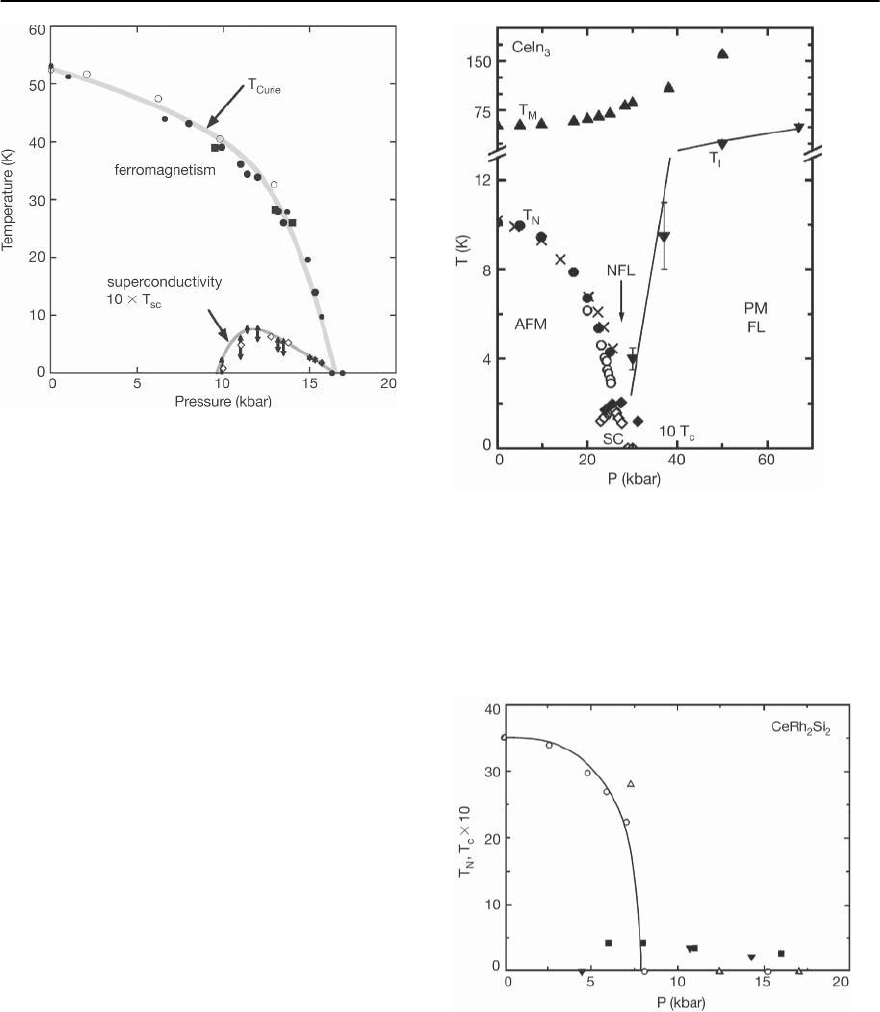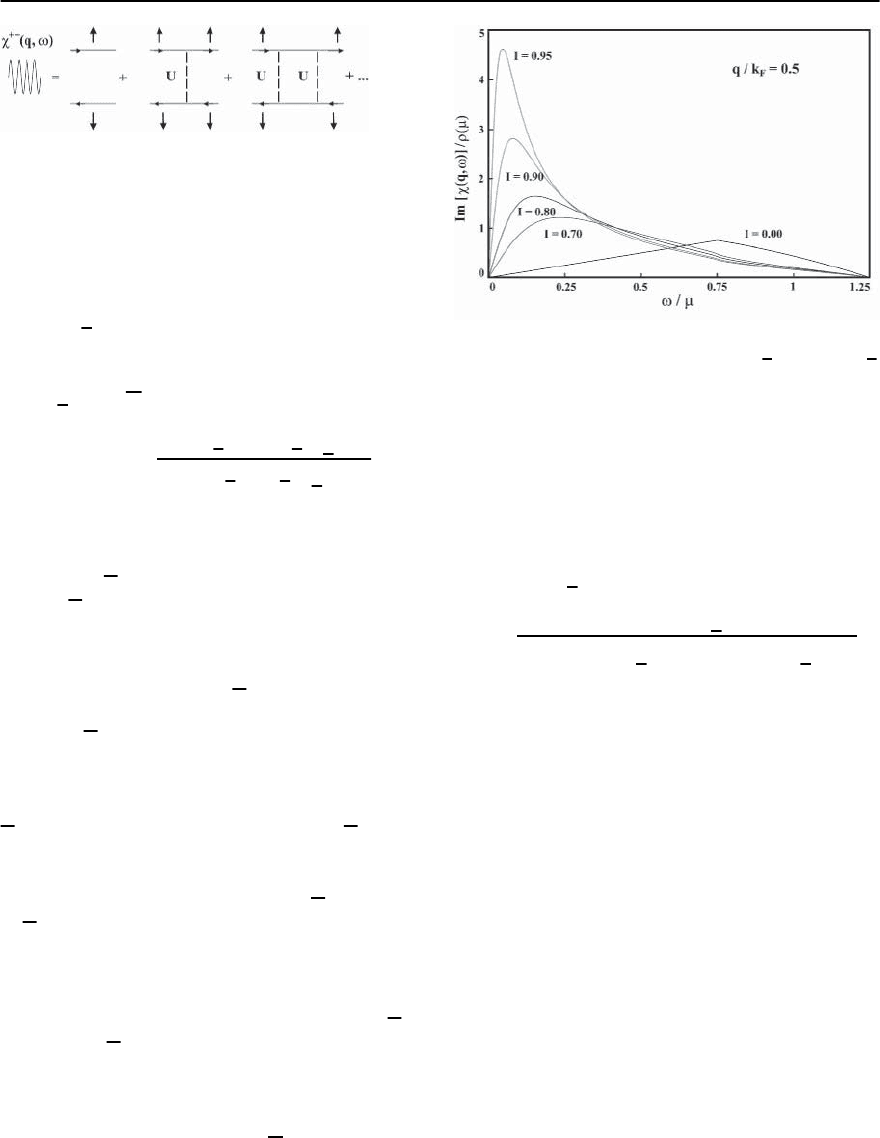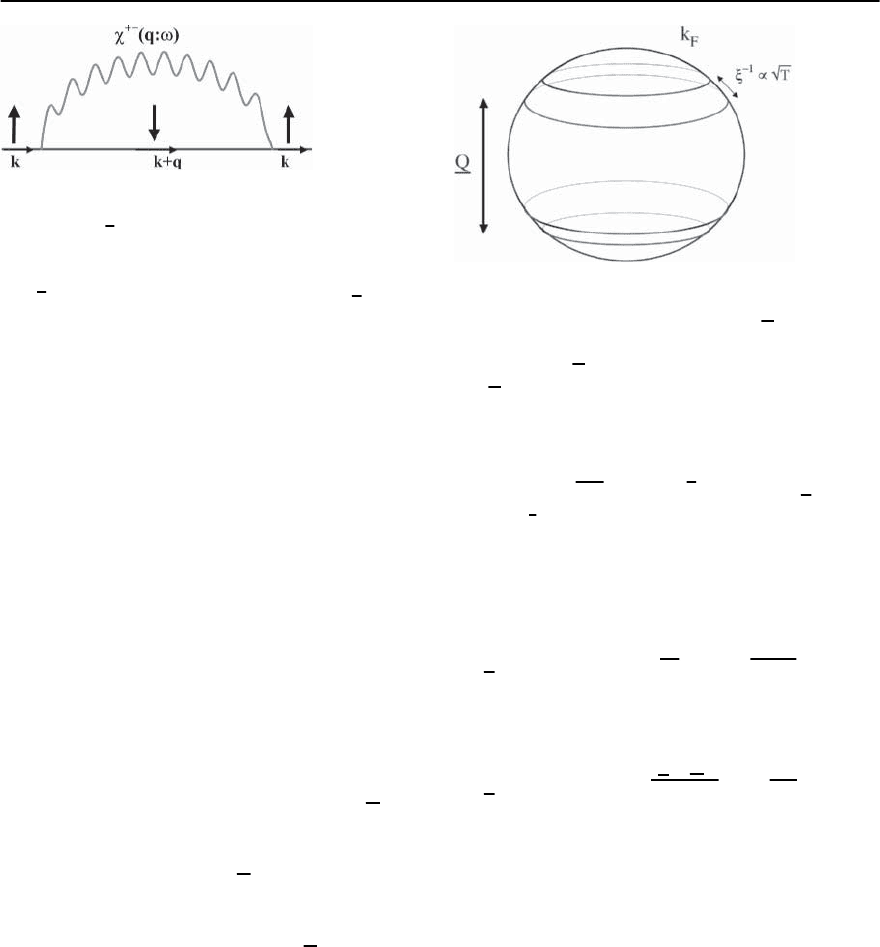Bennemann K.H., Ketterson J.B. Superconductivity: Volume 1: Conventional and Unconventional Superconductors; Volume 2: Novel Superconductors
Подождите немного. Документ загружается.


1040 P.S. Riseborough,G.M. Schmiedeshoff,and J.L.Smith
Fig. 19.8. The pressure-temperature phase diagram of the
ferromagnetic superconductor UGe
2
[67]. The Curie tem-
peratures were determined from the susceptibility (filled
circles), resistivity (open circles) and neutron diffraction
(squares). The onset and completion of the resistive su-
perconducting transition are shown by the filled triangles.
Note the change of scale for the superconducting transition
temperature
these systems the Cooper pairs are in a triplet state.
However,if this is the case, there seems to be no com-
pelling reason as to why the superconducting phase
should be restricted to only occur inside the ferro-
magnetic phase. On the other hand, if the ferromag-
netic state can be described strictly as a local Fermi
liquid [70], then it has been rigorously shown [71]
that there is an attractive s-wave interaction and the
triplet interaction is identically zero. Furthermore, a
mean field analysis shows that a singlet supercon-
ducting state in a ferromagnet may survive if the
pair breaking due to the uniforminternal fieldis suf-
ficiently strong [72].
The observation of the superconducting phase
within ferromagnetic and antiferromagnetic phases
with low transition temperatures shows that the
heavy-fermion materials are often correlated with
the proximity of a quantum critical point [73–75].
This point is illustrated by the phase diagrams shown
in Figs. 19.8 through 19.10. At a quantum criti-
cal point, the large amplitude low frequency mag-
netic fluctuations could produce appreciable con-
Fig. 19.9. The pressure-temperature phase diagram of the
antiferromagnetic superconductor CeIn
3
[65]. The Neel
temperature and superconducting transition temperatures
are denoted by T
c
and T
N
,respectively.NotethatT
c
is scaled
by a factor of 10. T
M
denotes the temperature of the maxi-
mum in the resistivity, while T
I
indicates a temperature at
which the system crosses over into a Fermi liquid phase
Fig. 19.10. The pressure-temperature phase diagram of
the antiferromagnetic superconductor CeRh
2
Si
2
[69]. The
solid symbols represent the superconducting transition
temperature T
c
,whiletheopen symbols denote the Neel
temperature T
N

19 Heavy-Fermion Superconductivity 1041
tributions to physical properties that are different
from those expected of highly renormalized quasi-
particles. The existence of large amplitude magnetic
fluctuations associated with the quantum critical
point leads to another exciting possibility namely,
that the superconducting pairing mechanism for the
quasi-particles is primarily mediated by low-energy
spin-fluctuations [76]. Either the characteristic fre-
quency of the low-energy spin-fluctuations or the
mass renormalizations associated with the heavy
quasi-particles presumably, could be responsible for
setting the low values of the superconducting tran-
sition temperatures, T
c
. Generally, heavy-fermion
superconductors have superconducting transition
temperatures in the range between 0.2 and 3 K. The
compound PuCoGa
5
provides a notable exception to
this statement, as it has a T
c
of about 18.5 K, which
is the highest reported T
c
for a heavy-fermion super-
conductor [77]. The low values of T
c
found in most
heavy-fermion superconductors are in stark contrast
with the very large critical temperatures found in
the other well known examples of exotic supercon-
ductivity – the high temperature superconducting
cuprates.
19.2.3 Quasi-Particles and Collective Excitations
At high temperatures, the properties of heavy-
fermionsystemscanoftenbedescribedintermsof
a set of local moments coupled to a sea of conduc-
tion electrons. At temperatures below a characteris-
tic temperature, sometimes known as the coherence
temperature, the properties show evidence that the
excitations have large spatial extents. Below the co-
herence temperature, the transport properties indi-
cate that the scattering from the spin degrees of free-
dom start to freeze out and that the electronic excita-
tions extend throughout the crystal. For sufficiently
low temperatures,one may expect that the properties
will be described by the quasi-particle excitations of
Landau Fermi liquid theory. However, in a few of
the heavy-fermion systems, the Fermi liquid state is
never completely formed before superconductivity
sets in. In these cases one expects that, below the
coherence temperature, the properties may be de-
termined by the low-energy excitations that include
both the collective excitations, such as phonons and
spin-waves, as well as the quasi-particle excitations.
Quasi-Particle Excitations
Elementary excitations can be categorized either as
quasi-particlesorascollective excitations.Thequasi-
particle excitations are in one-to-one correspon-
dence with the excitations of the non-interacting
system. The quasi-particle excitations have a close
similarity to the single-electron excitations of a non-
interacting electron gas. The properties of these
quasi-particles are most readily seen through in-
spection of the one-electron thermal Green’s func-
tion [78] defined by the expectation value of the time
ordered product of the thermal average
G
˛,ˇ
k
,k
()=−
1
< |
ˆ
Ta
k
,ˇ
()a
†
k
,˛
(0)| >. (19.2)
The Green’s function represents the time evolution of
the probability amplitude for a single electron to be
added to the Bloch state with wave vector k
and spin
. The electron creation and annihilation operators
are evaluated in the imaginary time representation
wheretheyevolveaccordingtotheprescription
a
k,˛
()=exp
+
ˆ
H
a
k,˛
()exp
−
ˆ
H
. (19.3)
Due to periodic translational invarianceand spin ro-
tational invariance of the normal state, the Green’s
function is diagonal in the wave vector and spin in-
dices
G
˛,ˇ
k
,k
()=ı
˛,ˇ
ı
k,k
G(k; ) . (19.4)
The Fourier transform of the diagonal Green’s func-
tion is defined via
G(k
; )=k
B
T
n
G(k; i!
n
)exp
−i!
n
, (19.5)
where
!
n
= k
B
T(2n + 1) (19.6)
are the Matsubara frequencies. The interacting
Green’s function is expressed in terms of the non-

1042 P.S. Riseborough,G.M. Schmiedeshoff,and J.L.Smith
interacting Green’s function G
0
(k, i!
n
)andtheself-
energy £(k
, i!
n
)throughDyson’sequation
G(k
; i!
n
)
−1
=
G
0
(k; i!
n
)
−1
− £(k; i!
n
) ,
(19.7)
where the non-interacting Green’s function is evalu-
ated as
G
0
(k; i!
n
)
−1
= i !
n
− e(k)+ . (19.8)
The pole of the non-interacting Green’s function is at
the single-electron Bloch energy e(k
)−,andmea-
sures the excitation energy relative to the Fermi en-
ergy. The self-energy represents the change in the
Green’s function due to the interactions. The Fermi
energy of the interacting system, , is determined by
thepoleoftheGreen’sfunctionat!
n
=0,which
leads to
= e(k
F
)+£(k
F
;0), (19.9)
where k
F
is a Bloch vector on the Fermi surface.The
thermal Green’s function is related to the T =0
Green’s function via analytic continuation i!
n
→
E. The correspondence between quasi-particle ex-
citations and the single-electron excitations of the
non-interacting system follows from the expansion
of the self-energy near the Fermi energy. For ener-
gies close to the Fermi energy, the Green’s function
can be re-written as
G(k
; E)
−1
≈ E
1−
∂£(k
; E)
∂E
!=0
− e(k)−£(k;0)+ − iIm£(k; E)
=
1−
∂£(k
; E)
∂E
!=0
×
E − E
k
+
i
2
∗
k
(E)
. (19.10)
The interaction produces a linear superposition of
theelectron in a Bloch statek
with one-electron states
surrounded by a cloud of electron-hole pairs. The
quasi-particle weight, Z
−1
k
,representsthefractionof
this superpositionthat corresponds to the bare Bloch
electron. The fraction is less than unity Z
k
> 1, and
Z
k
is given in terms of the frequency derivative of the
self-energy by
Z
k
=1−
∂£(k
; E)
∂E
E=0
. (19.11)
The quasi-particle energy E
k
,measuredfromthe
Fermi energy , and the decay rate are given by
E
k
= e(k)+£(k; E
k
)− ,
E
k
≈ Z
−1
k
e(k
)+£(k;0)−
, (19.12)
and
2
∗
k
(E)
=−Z
−1
k
Im£(k; E + iı) , (19.13)
respectively. Since the imaginary part of the Green’s
function is proportional to the single-particle den-
sity of states,the self-energy can be viewed as a renor-
malization of the single-electron excitation energies
e(k
),yielding the quasi-particleenergy E
k
.Theimag-
inary part of the self-energy can be viewed as provid-
ing the width or lifetime of the single-particle state.
As shown by Luttinger [79], the imaginary part of the
self-energy near the Fermi energy due to electron–
electron interactions vanishes proportional to E
2
,if
perturbation theoryconverges.The small magnitude
of the lifetime is due to the Pauli exclusion principle
which reduces the phase space allowed for electron–
electron scattering. The smallness of the lifetime of
low-energy excitations has the effect that the spec-
trum resembles that of a non-interacting electron
gas in which the quasi-particle masses are enhanced
by a factor of Z
k
. The quasi-particle states are ex-
tremely long lived, not only because of the vanishing
of the lifetime due to electron–electron interactions
but also because the residual lifetime resulting from
elastic scattering by impurities is enhanced by the
factor of Z
k
. Due to the extremely small magnitude
of the lifetime of quasi-particles at the Fermi energy,
the Fermi energy is well defined and the effect of
electron–electron interactions does not change the
volume enclosed by the Fermi surface [79].It is found
that,in de Haas–van Alphen experiments on some of
the heavy-fermion systems, the multi-sheeted Fermi

19 Heavy-Fermion Superconductivity 1043
surfaces enclose volumes that are consistent with
Luttinger’s theorem being valid. For heavy-fermion
systems, the k
dependence of the self-energy is con-
sidered to be small, and the frequency dependence
is extremely rapid. Thus, the quasi-particles are ex-
pected to be extremely heavy and long-lived but have
little spectral weight. Also, a large portion of the
weight is expected to lie in the broad incoherent por-
tion of the spectral density.
Since the quasi-particles are governed by Fermi–
Dirac statistics, their contributions to thermody-
namic quantities have asymptotic low temperature
variations that are similar to those of the non-
interacting electron gas. In particular, the entropy
S of the gas of quasi-particles is given by
S =−k
B
,k
(1 − f (E
k
)) ln[1 − f (E
k
)]
+ f (E
k
)ln[f (E
k
)]
. (19.14)
Hence, the quasi-particles give rise to a linear T con-
tribution in the low temperature electronic specific
heat. However, the coefficient , instead of just re-
flecting the electronic density of states, is given by
the density of quasi-particle energies at the Fermi
surface
qp
(E)=
k
ı(E − E
k
) ,
qp
(0) ∼
k
Z
k
ı( − e(k)+£(k; 0))) , (19.15)
which is enhanced over the electronic density of
states () by a factor Z similar to the Fermi surface
average of Z
k
. Comparison of the low temperature
electronic specific heat coefficient and electronic
structure calculations, yields an estimate of the wave
function renormalization Z of approximately 25 for
highly enhanced systems such as UPt
3
. The heavy
quasi-particle masses in some or all parts of the
Fermi surface can also be inferred from the am-
plitude of the de Haas–van Alphen oscillations in
the magnetization [80]. The signatures of the gas
ofheavyquasi-particlesmayalsobeexpectedto
show up in transport properties, albeit modified by
the residual interactions between the quasi-particles.
The temperature dependence of the d.c. resistivity of
the enhanced Fermi liquid state is dominated by the
transport scattering rate.If the self-energy is roughly
k independent, the transport scattering rate should
coincide with the scattering rate
1
found from the
imaginary part of the self-energy since the conduc-
tivity vertex corrections are expected to be small.
For low temperatures and samples of high purity,
Matheissen’s rule is expected to apply. In this case,
the scattering rate is additive, and
1
is expected to
be composed of a sum of a temperature indepen-
dent term
1
0
due to the potential scattering from iso-
lated impurities, a quadratic Baber term caused by
the quasi-particles scattering off of each other, and
a negligibly small T
5
term expected from electron–
phonon scattering
1
=
1
0
+ AT
2
+ BT
5
. (19.16)
If the impurity scattering can be treated in the Born
approximation, then, due to the approximate invari-
ance of the density of states at the Fermi energy, the
impurity scattering rate
1
0
is not directly renormal-
ized by the electron–electron interactions. The T
2
Baber term has its originin the Pauli-exclusion prin-
ciple limiting the phase space available for scatter-
ing of low-energy electrons, and is exactly the same
physics behind theE
2
variation ofthe imaginary part
of the self-energy. Since Baber scattering involves
the scattering of two quasi-particles, the scattering
rate is enhanced by a factor proportional to Z
2
.The
residual d.c. conductivity does not directly depend
on the real part of the self-energy and is, therefore,
un-renormalized. Alternately, the d.c. residual resis-
tivity is un-renormalized due to the small magnitude
of the velocity vertex correction, and due to the can-
celationofthewavefunctionrenormalizationinthe
ratio of the renormalized quantities
∗
m
∗
≈
m
(19.17)
and also because the electron density n is unchanged
by electron–electron interactions. This last fact is
seenby noting thatn is proportional to the Fermi sur-
face volume which,according to Luttinger’s theorem,
is independent of the strength of electron–electron

1044 P.S. Riseborough,G.M. Schmiedeshoff,and J.L.Smith
Fig. 19.11. The optical conductivity (!)ofsinglecrystals
and polycrystals of UPt
3
at T =1.2KandT = 20 K [81].
The data show the growth of the narrow quasi-particle
Drude peak at low temperatures
interactions.Despitethe absenceofsignificantrenor-
malization of the d.c. conductivity, the renormalized
lifetimes do show up as extremely narrow widths of
the Drude peak [81–83]
Re
(!)
=
ne
2
∗
m
∗
1
1+!
2
∗ 2
(19.18)
observed in measurements of the dynamical con-
ductivity (!) at low temperatures. The frequency
dependence of the measured conductivity (!) for
UPt
3
[81], is shown in Fig. 19.11 for low and high
temperatures. Basically, if one has a fixed concen-
tration of impurities, and hence a fixed mean free
path, then the quasi-particle lifetime is just deter-
mined by the quasi-particle velocity k
F
/m
∗
,which
is reduced by the large quasi-particle mass. There-
fore, the enhanced effective mass results in an en-
hancement of the lifetime due to impurity scatter-
ing. At higher frequencies, one expects that inelastic
scattering processes should become important and
the quasi-particle weight should acquire a frequency
dependence. The frequency dependence of the scat-
tering rate and the quasi-particle renormalization
are expected to be related by causality and other re-
quirements. In particular, the optical sum rule [84]
relates the integral of the optical conductivity over
all frequencies to the total number of electrons in
the system
∞
0
d! Re
(!)
=
2
ne
2
m
e
, (19.19)
where n is the density of electrons and m
e
is the elec-
tron mass. Similarly, the integrated intensity of the
low frequency Drude peak
!
0
0
d!Re
(!)
=
2
n(!
0
)e
2
m
∗
(19.20)
can be used to define the number of coherent quasi-
particles n(!
0
) and their weight Z
−1
[85], whereas
the higher energy structure is due to the incoher-
ent excitations. The existence of the quasi-particle
Drude peak has been confirmed in UPt
3
,CeAl
3
and
CeCoIn
5
[81,82,86],however,ithasnotbeenobserved
in UBe
13
[87] where it is doubtful that a Fermi liquid
is formed at temperatures higher than the supercon-
ducting T
c
.In thecaseswherethe Fermi liquidisfully
formed, it is not expected that good agreement will
be found between the optical effective mass, whose
definition involves the Fermi surface average of the
inverse quasi-particle mass, and the Fermi surface
average quasi-particle mass obtained from specific
heat.The disagreement is expected to be marked spe-
cially if the de Haas–van Alphen experiments show
both light and heavy quasi-particle excitations co-
existing on the Fermi surface.
In systems like UBe
13
,the Fermi liquid phase is not
completely formed before superconductivity sets in,
therefore, the thermodynamic and transport prop-
erties may be directly affected by the collective exci-
tations of the electrons. In addition, the large mass
renormalization Z of the quasi-particles might also
be attributable to the existence of low frequency col-
lective excitations, such as local spin-fluctuations or
more extended magnetic excitations that are precur-
sors of long-ranged magnetic ordering. The collec-
tive excitations are directly amenable to experimen-
tal observation and also may mediate residual inter-
actions between the quasi-particles, and therefore,
they could be responsible for the superconducting
pairing.

19 Heavy-Fermion Superconductivity 1045
Collective Excitations
Since the normal states of heavy-fermion materials
are characterized by a large quasi-particle density of
states near the Fermi-level, they are susceptible to
entropy-driven instabilities, which reduce the den-
sity of states at the Fermi energy. This tendency is
manifested by the sensitivity of the normal state to
small amounts of added impurities that can lead to
an instability towards states with spontaneously bro-
ken symmetries. If the interactions are short-ranged
and the symmetry that is broken is continuous,Gold-
stone’s theorem [88] is valid. Goldstone’s theorem
ensures that the system will support a branch of
collective excitations with a zero threshold energy
that dynamically restores the spontaneously broken
symmetry.The order parameter acts as the collective
coordinate for the zero energy collective excitations.
Thespin-waveswithq
≈ 0 in a ferromagnet,the anti-
ferromagnetic spin-waves near the critical wave vec-
tor(s) Q
c
, and the transverse sound waves in a peri-
odic solid, form well known examples of these Gold-
stone collective modes. Similar boson-like collective
excitations are expected to occur in the disordered
or high temperature state as precursors to the insta-
bilities. In the disordered state, these boson modes
are expected to have extremely long lifetimes and
have excitation spectra that form broad continua. A
well known example of these precursor modes is pro-
vided by the paramagnon fluctuations in Pd, which
occur as Pd is very close to an instability to a fer-
romagnetic state [89–91]. It is expected that, as the
temperature is lowered through the instability,these
pre-criticalmodes will merge together with the criti-
cal fluctuationsand,eventually,the (Goldstone) spin-
wave modes will emerge in the orderedstate.There is
a growing body of evidence that suggests that heavy-
fermionsystemsareinthevicinityofaquantumcrit-
ical point, implying that the system supports large
amplitude critical fluctuations due to a nearby T =0
phase transition. One expects that the properties of
the material should show scaling behavior due to
the quantum critical point. The critical fluctuations
near a quantum critical point are expected to have
a different nature than those associated with a fi-
nite temperature transition as they cannot be treated
classically [73–75]. The zero-point quantum fluctu-
ations replace the role of the thermally-driven fluc-
tuations. Since the dynamics are inextricably linked
to the statics at a quantum critical point, the phase
space of the magnetic fluctuations is given by (!, k
).
If the characteristic frequency scales as
−z
,where
is the magnetic correlation length and z is the dy-
namical exponent, then the effective dimensionality
of the phase space for a T =0quantumcriticalpoint
is given by d
eff
= d +z. Hence, as the effective dimen-
sionality d
eff
differs from the dimensionality d of the
classical critical point, one expects to find different
types of scaling relations at a quantum critical point.
Thesearchfortheultimatedescriptionofquantum
critical fluctuations is an actively ongoing field of
research.
The simplest starting point for these theories of
the collective spin-fluctuation modes lies in the ran-
dom phase approximation (RPA) [92,93]. The RPA is
the crudest approximation that captures the physics
of the Gaussian fluctuationsand is most certainly ex-
pected to fail near the quantum criticalpoint.In most
approaches, one assumes that the Coulomb interac-
tion is highly screened, and this results in a Hubbard
point contact interaction U between electrons of op-
posite spins.Within the quasi-particle treatment,the
band energies e(k
) should be replaced by the quasi-
particle energies E
k
, and the interaction should be
expressed in terms of the Landau Fermi-liquid pa-
rameters.However,we shall,in the rest of this section,
be consistent with the usual formulation of RPA as a
one parameter Fermi liquid, in which the interaction
between the quasi-particles is denoted by U.Since we
shallneglect the vertex corrections to thesusceptibil-
ity, we shall also suppress all the factors of Z
−1
,while
it is true that Fermi liquid correctionsshould renor-
malize U to UZ
−2
. Although the results are derived
on the basis of a one band Hubbard model, they can
easily be extended to a two band or Anderson Lat-
tice model [94]. The transverse susceptibilities are
expressed in terms of multiple scattering processes
involving an up-spin electron with a down-spin hole
shown in Fig. 19.12 [92,93], yielding
+−
(q; !)=
2
B
0
(q; !)
1−U
0
(q; !) ,
(19.21)

1046 P.S. Riseborough,G.M. Schmiedeshoff,and J.L.Smith
Fig. 19.12. Diagrammatic representation of the Feynmann
diagrams leading to the RPA expression for the transverse
spin-fluctuations. The directed solid lines denote the one-
electron Green’s functions. The vertical arrows represent
the directions of the electronic spins. The dashed vertical
line represents the on-site Coulomb interaction U
where
0
(q; !) is the non-interacting Lindhard sus-
ceptibility, given by
0
(q; !)=
1
N
k
(19.22)
×
f (e(k
)) − f (e(k + q))
! − e(k )+e(k + q)+i ı
.
In the RPA, a magnetic instability of the paramag-
netic state towards an ordered state with ordering
wave vector Q
is obtained when the static suscepti-
bility (Q
; 0) diverges, which occurs due to the van-
ishing of a denominator.This happens when the gen-
eralized Stoner criterion is fulfilled,
1=U
0
(Q;0), (19.23)
where
0
(Q; 0) is the reduced non-interacting sus-
ceptibility. The paramagnetic state is unstable for
values of U greater than a critical value U
c
where
the equality of (19.23) first holds, at any value of
Q
. The type of instability, determined by Q and the
critical value of U at which it occurs, is governed
by both the quasi-particle band structure and the
state of occupation of the bands. If
0
(Q;0)islargest
at Q
= 0, the system is expected to become unsta-
ble to a ferromagnetic state at a critical value of U
determined by the usual Stoner criterion for ferro-
magnetism, 1 = U
c
(). For perfect nesting tight-
binding bands at half filling, one finds that (Q
;0)
diverges for Q
= (1, 1, 1), leading to an instabil-
ity towards an antiferromagnetic state for U greater
than the critical value of U
c
= 0 [95].In general,for U
values close to the critical value U
c
, the static suscep-
tibility evaluated at the relevant Q
is enhanced, and
Fig. 19.13. The frequency variation of Im(q; !) for fixed q.
The parameter I is given by I = U(). The damped spin-
fluctuations soften and grow in amplitude as the quantum
critical point is approached. [After Doniach [96]]
the imaginary part of the susceptibility undergoes
a similar enhancement. Since the imaginary part of
the susceptibility is a measure of the spectrum of
magnetic excitations, the enhanced RPA expressions
Im
+,−
(q; !)
= (19.24)
2
B
Im
+,−
0
(q; !)
[1 − URe
+,−
0
(q; !)]
2
+[UIm
+,−
0
(q; !)]
2
show the propensity for low frequency large am-
plitude spin-fluctuation excitations, as shown in
Fig. 19.13. Near the instability, the magnetic exci-
tation spectrum consists of a continuum of low-
energy (quasi-elastic) and over-damped precritical
fluctuations from which, on increasing U above U
c
,a
branch of sharp spin-wave excitations are expected
to emerge in the magnetically ordered state.
The large amplitude spin-fluctuationsare also ex-
pected to give rise to a renormalization of the quasi-
particles. The change in the energies of the quasi-
particles shows up in the RPA self-energy due to
the emission and absorption of spin-waves, which
flip the spin of the electron (see Fig. 19.14). The
quasi-particle weight of the low frequency excita-
tions is reduced as the scattering from the large am-
plitudespin-fluctuationsreduces the probability that
the electron remains in a spatially extended Bloch
state. For a nearly ferromagnetic system, this leads

19 Heavy-Fermion Superconductivity 1047
Fig. 19.14. The RPA expression for the up-spin electron
self-energy £(k
; E ). The one-electron Green’s function is
denoted by the directed line, and the spin-fluctuation by a
wavy line. In this process, an up-spin electron of momen-
tum k
emits a spin-fluctuation of momentum q,thereby
flipping its spin
to a logarithmic enhancement of the linear term in
specific heat [90,91] via
C ∝ k
B
T ln
1−U()
. (19.25)
Using a Fermi liquid approach, Carneiro and
Pethick [97] have shown that long wavelength col-
lective fluctuations can also lead to a T
3
ln T term
in the specific heat similar to that found in para-
magnon theories [98]. Likewise, the collective fluc-
tuationsalsocanleadtoanenhancementofthe
quasi-particle scattering rate which in turn, leads
to an enhanced T
2
term in the electrical resistiv-
ity [89, 99]. The precise form of the renormaliza-
tion found in RPA does depend crucially on the type
of magnetic instability (ferromagnetic, incommen-
surate spin density wave, antiferromagnetic) that is
being approached. For example, in quantum phase
transitions with finite ordering wave vectors Q
,elec-
trons are resonantly scattered by magnetic fluctu-
ations between portions of the Fermi surface that
areconnectedbythevectorQ
(see Fig. 19.15). This
leads to the occurrence of hot lines on the Fermi sur-
face where the quasi-particles are extremely short
lived and, therefore, are not well-defined. The size of
these hot regions is proportional to
√
T. On the other
hand,for a ferromagnetic quantum critical point,the
entire Fermi surface is subject to critical scattering.
The different nature of the critical scattering results
in different power law temperature dependences of
various physical quantities [100]. For example, the
leading non-analytic part of the free energy F is
given by
Fig. 19.15. Hot lines on a Fermi surface. The dynamic sus-
ceptibility becomes critical at wave vector Q
. The electrons
on the two lines of the Fermi surface which are connected
by wave vector Q
are subject to resonant scattering. The
width of the hot lines is given by
−1
, which is proportional
to
√
T
F =
q
∞
0
d!
N(!)+
1
2
Im
ln U (q
; !)
,
(19.26)
where N(!) is the Bose–Einstein distribution func-
tion, and the spin-fluctuation propagator either has
the form
(q
; !)
−1
∼ (1−I)+a
q
k
F
2
+ib
!k
F
q
(19.27)
near a ferromagnetic instability or has the form
(q
; !)
−1
∼ (1−I)+a
(q
− Q)
2
k
2
F
+ib
!
(19.28)
near an antiferromagnetic instability. For a d-
dimensional system that is above the critical dimen-
sionality, at a quantum critical point where I =1,
this produces a leading T
1+d/3
temperature depen-
dence of F for a ferromagnetic quantum critical
point, but near an antiferromagnetic quantum criti-
cal point F has a T
1+d/2
dependence. The tempera-
ture dependence of F gives rise to the non-analytic
temperature dependences of the C/T ratio.
Close to a quantum critical point,where both ther-
maland quantum critical fluctuations are important,
the properties are expected to be significantly dif-
ferent from the properties calculated using simple

1048 P.S. Riseborough,G.M. Schmiedeshoff,and J.L.Smith
RPA.At finite temperatures and in the quantum crit-
ical region, the effect of coupling among the dif-
ferent modes of spin-fluctuations becomes impor-
tant [101]. The theories of Moriya [93], Hertz [73]
and Millis [75] predict that three-dimensional elec-
tronic systems at a quantum critical point have an
effective dimensionality greater than the upper crit-
ical dimension and, hence, are dominated by Gaus-
sian spin-fluctuations,albeithighly renormalized by
mode–mode coupling. In this case, the hyperscaling
relation is not expected to be obeyed. The strength
of the mode–mode coupling is expected to vanish at
zero temperature. It is generally believed that the re-
gion over which the Fermi liquid behavior is found,
is smaller for systems which are close to exhibiting
a magnetic instability.Furthermore, as the quantum
critical point is approached, the Fermi liquid power
laws are expected to be gradually replaced by other
types of non-universal power laws. For example, the
T
2
variation of the resistivity found in the Fermi liq-
uid regime of a clean three-dimensional metal is ex-
pectedtobereplacedbyaT
5
3
variation at a ferro-
magnetic quantum critical point or a T
3
2
variation at
an antiferromagnetic quantum critical point. These
power laws are intermediate between the low tem-
perature Fermi liquid T
2
variation and the linear T
variation found within RPA at higher temperatures
and are consistent with expectations based on the
shrinking temperature range over which Fermi liq-
uid behavior is to be observed. The simple power
laws obtained using self-consistent spin-wave theory
are only expected to be recovered at low tempera-
tures. Furthermore, the scaling behavior expected
from the quantum critical point is expected to be
severely modifiedbytheeffectsof disorder[102,103].
In the case of an antiferromagnetic quantum critical
point in a clean system, the hot lines are not expected
to dominate drastically the low temperature physi-
cal properties, since the hot lines have a limited ex-
tent. For example, the contributions of the hot lines
to the conductivity are expected to be shorted out
by the normal regions of the Fermi surface [104].
Table 19.1. Quantum critical exponents for physical prop-
erties
d =3 Ferro Antiferro
C/T −lnT − ˛
√
T
−1
Q
T
4
3
T
3
2
T
5
3
T
3
2
d =2 Ferro Antiferro
C/TT
−
1
3
−lnT
−1
Q
−T ln T −T/ ln T
T
4
3
T
However, the presence of impurities leads to k not
being a good quantum number since electrons are
inelastically scattered between different portions of
the Fermi surface. Hence, the mixing between differ-
ent k
values results in all the electrons on the Fermi
surface participating in the critical scattering [103].
In general,the power laws found in heavy-fermion
systems do not coincide with those found in the
above-mentioned type of two or three-dimensional
theories (shown in Table19.1).Onepossiblecause for
this discrepancy is perhaps due to the heaviness of
the quasi-particle masses. That is, in the above the-
ories, the electron dynamics are assumed to occur
on a fast energy scale compared with the slow criti-
cal fluctuations, therefore the fast electron dynamics
can be integrated out.For systems with high effective
masses, such descriptions may no longer be appro-
priate [105]. Related ideas about the lack of scaling
being caused by the breakdown of the quasi-particle
concept have been expressed by Coleman [106].An
alternate possible cause for the discrepancy could be
due to the nature of the assumed theoretical model.
2
Generally, it has been assumed that strong electron–
electron interactions, which give rise to the forma-
tion of heavy quasi-particles and strong magnetic
fluctuations,are unfavorablefor the formation of su-
perconducting pairs. However,the observation of su-
perconducting phases only in the immediate vicinity
of quantum critical points, as sketched in Fig. 19.16,
2
The Moriya,Hertz,Millistheory assumesthevalidity ofa non-degenerateone-bandmodel,whereasmulti-band models,
with orbital degeneracy and strong spin-orbit coupling, appear to be more appropriate for describing heavy-fermion
systems. These other models may be in a different universality class and, hence, have other critical exponents.

19 Heavy-Fermion Superconductivity 1049
Fig. 19.16. A schematic pressure-temperature phase dia-
gram near a quantum critical point (QCP). The solid lines
T
N
and T
c
, respectively, denote the transition temperatures
to the N´eel and superconducting phases. The dashed lines
represent the characteristic temperatures associated with
the Kondo effect, T
K
and the low temperature Fermi Liq-
uid T
FL
challenges the assumption. These observations sug-
gest that the large amplitude quantumcriticalfluctu-
ations might even be responsible for the occurrence
of the superconductivity. The two most outstand-
ing questions about the superconductivity in heavy-
fermion systems concern the nature of the pairing
mechanism and the symmetry of the superconduct-
ing order parameter.
19.2.4 Possible P airing Mechanisms
The interaction mechanism that is responsible for
pairing electrons in commonsuperconductorsis me-
diated by phonons. Fr¨ohlich [107] predicted that the
superconducting transition temperature T
c
should
be proportional to a typical phonon frequency. Fur-
thermore, as the phonon frequency squared is in-
versely proportional to the mass of the ions, M,
Fr¨ohlich predicted that the transition temperature
should vary as
T
c
∝ M
−
1
2
. (19.29)
This dependence of T
c
on the mass was confirmed
by experiments by Maxwell [108] and Reynolds et
al. [109] who measured T
c
for samples composed of
different isotopes. This isotope effect has been ob-
served in a number of simple materials such as Hg,
Pb, Mg, Sn, Tl. For these simple metals, the retarded
electron–electron attraction,due to the charged ions
over screening the Coulomb interaction [110],has a
simple mass dependence. The isotope effect is much
smaller or even almost absent in transition metals
and compounds such as Ru and Os, where the elec-
trons are more localized and the relative strength of
the Coulomb repulsion is large [111]. In ˛ − U ,a
large isotope effect even occurs with a positive expo-
nent [112],but detailed calculationsshow that the su-
perconductivity is still phonon mediated [113]. The
absence of an isotope effect does not necessarily im-
ply non-phonon mediated electron–electron interac-
tions but merely that simplifying circumstances that
lead to Fr¨ohlich’s isotopic mass dependence are not
present. As heavy-fermion systems have extremely
heavy quasi-particle masses due to large electron–
electron interactions, one does not expect isotope
experiments to provide direct evidence of the nature
of the pairing mechanism. Furthermore,for systems
that appear to be on the verge of a magnetic instabil-
ity [114,115],it is possible that the collective excita-
tions of the spin system could provide an alternate or
complementary mechanism to the phonon mediated
interaction.
Many different pairing mechanisms have been
proposed for heavy-fermion superconductors,rang-
ing from electron–phonon coupling [116,117] to fer-
romagnetic and antiferromagnetic spin-fluctuations
[118–120]. The main problem posed in developing
a microscopic description of the superconductivity
lies with the lack of knowledge of thenormal statebe-
cause of its strong electron correlations.A commonly
used approach that describes the formation of the su-
perconducting state starts from assuming the valid-
ity of a Fermi liquid description of the normal state.
In what follows, we shall outline this approach to
superconductivity. However, as some heavy-fermion
superconductors show no evidence that a Fermi liq-
uid state has formed before the superconducting
transition has occurred, this approach is not on a
firm basis. Second, as the Fermi liquid approach
neglects the effect of the collective fluctuations, it
does not address the role that the low-frequency
spin-fluctuations play in suppressing the supercon-
ducting transition. The proper starting point for a
